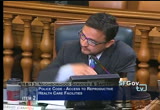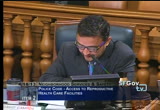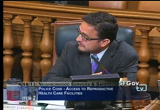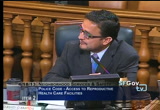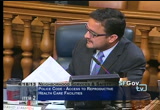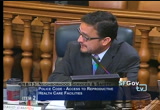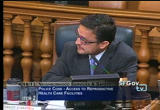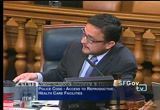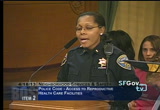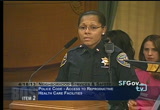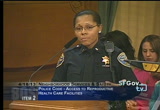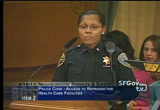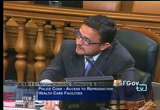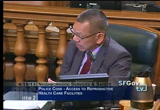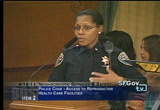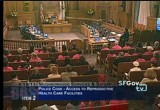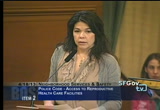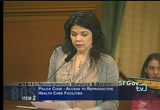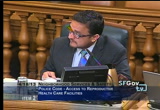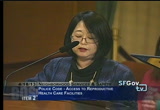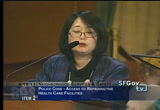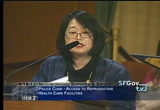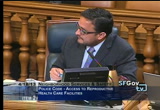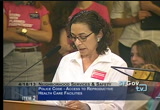tv [untitled] April 21, 2013 5:14am-5:44am PDT
5:14 am
by an anti-protester. dr. tiller, unfortunately would survive that shooting but then would be shot and killed 16 years later by another anti-activity. that same year that all of that was happening. this board of sburps has the access to healthcare facilities ordinance in an attempt to insure that the men, women and families that walked through the doors of the productive health facilities are saved from threats, violence, intimidation and harassment and it has been more than 20 years and much has happened, unfortunately in some respects not much has changed. last year we saw the bombing of two representative healthcare facilitis in a third that was burned to the ground over night. must has been said about the war on women, but we believe those of us who have been
5:15 am
seeing these events unfold that the war on women is alive and well and we are seeing it here in san francisco. over the past year, we have been working with planned parenthood who approached my office and started telling us about the harassment that the workers at planned parenthood and the men and women and families that were trying to access the clinic were being subjected to. what they described to us and what we subsequently saw the many times that we have visited has been very disturbing. you have a number of incidents of harassment, a number of incidents of intimidation and people who have gone into the clinic. and i think that you will hear from some of the staff and some of the women who are here tonight and today who can more eloquently speak to their experiences in terms of the
5:16 am
level of intimidation that we are talking about. when you heard that, we wanted to be measured in our response, we met with planned parenthood and police department and we met with the city attorney and we met with our various city agencies to see what was the most responsible and measured way to respond to these incidents. and the key question for us was what are the laws that are currently in place and how do we enforce those laws to make sure that these workers and these women are protected and that is when we started talking about forcing on enforcement of the bubble ordinance and something that we have tried and did for a while and quite frankly, the bubble ordinance has not worked. it has not given the tools for the city agencies that are involved to protect these women and these workers. and it is at that time that we
5:17 am
started thinking about different options after trying that kind of implementation, if you will, for a few months. and we talked about the creation of a white zone ordinance. and and again the goal here was to strike a balance between the protection of people's right to free speech. and the right of women and men and families to access healthcare at these clinics and an ordinance was crafted and interview and passed by this board of supervisor and we tried to enforce that white zone ordinance in conjunction with the bubble ordinance and yet the intimidation and the harassment has continued and there has been a continued effort to find loopholes in these laws to figure out how they can still engage in intimidation and still, and you know, in some little sense be
5:18 am
in compliance with these ordinances, and so we have finally reached a point where enough and enough. that what we respect the right to free speech that the right to free speech is not absolute but it ends when it turned into intimidation and harassment and when it actually has the effect of infringing on the right of men, women and families to access healthcare in these clinics that is why we are here today talking about a buffer zone ordinance. >> to be honest, for me, this is one of those pieces of legislation that i wish thative never had to introduce. the fact is that women have had the right to choose for many, many years, and it is really hard for me to understand how it is that in this day and age and in san francisco, of all places, we have a situation where women are indeed being prevented from exercising that right. the bubble ordinance, the buffer ordinance that we are
5:19 am
introducing today, is a buffer ordinance that was carefully drafted following the guideness, that federal courts have provided with respect to this matter. this piece of legislation is consistent with the ruling in the first circle in the kolen v, oakly, where it basically talked about how a buffer zone ordinance is a valid time, place, and manner regulation that truly strikes the right balance between the free speech and the right of people in our community to access healthcare in the stand alone klin i objects. this ordinance is contra neutral because it protects the rights of perspective patients, to these clinics, a perspective of what the message is. people, who have opposed buffer zones in the past have argued before courts that because
5:20 am
these buffer zones arguably prevent the close personal contact between the speaker and the patient, that somehow that violates the first amendment. the fact is that the courts have made it very clear that the right to the first amendment to free speech is not absolute and it is not absolute even in a public forum, that the government has every right to actually impose reasonable regulations as long as there are other alternatives for the individuals to engage in free speech. in this case, the individuals who want to engage in free speech in this area, will still have the ability to do that outside of the buffer zone. and if, and i would add from my own personal experience, having been to planned parenthood many times that if the goal is truly to engage in speed and not in intimidation and so there is no need to have that close
5:21 am
personal contact that we have seen because the only reason to have that close personal contact in my view, would be to entim intimidate these women. the courts have said this and this is what the courts have said in that case. as long as the speaker has an opportunity to reach the intended audience, the constitution does not insure that the speaker always will be able to employ the preferred method of communication. clearly some of these protesters would like to be close and personal, would like to have no distance between them and the women and men who are active in these clinics but they don't have the right to do that under the constitution. there is an interest that we in government have in protecting the women who are accessing these clinics and then in protecting the people who work there and i personally do not
5:22 am
believe that we in san francisco government have to wait until there is a tragic incident for us to take action. and lastly, i would say, that if we cannot protect the right of women, men and families to access these clinics here in san francisco, then what does that say for the rest of the country? that is why we are here today. >> so, with that, i would like to call upon, actually supervisor yee, i don't know if you want to say anything? >> i will save my remarks. >> okay. >> so with that, i would like to call up on a couple of folks who are here to present, i see captain dennis oleary but i know that lieutenant from the angle side station is here so if i could ask him to please
5:23 am
come up. >> and again, lieutenant as i noted in my remarks, one of the challenges that we have faced is the fact that it has been enforce a bubble ordinance. one of the questions that i have is always, you know, how do you know the bubble ordinance provides protective space for eight feet around the individual. but how do you know what is eight feet? what is 7, what is 6 feet? but i am wondering if you talk a little bit about your experience and the experience of the police department in terms of the enforcement. >> good morning, i'm lieutenant wering with the police department and i work out of engleside, i am here representing the district station captain and just to answer your questions about the bubble ordinance, where the challenge has been for us, is the way that the ordinance is
5:24 am
written, the language can be a little confusing in terms of where the actual eight feet began, is it with them standing in front of or once they walk, you know, once they walk to a position if they are leaning in in that point or if they are, you know, or if they are walking in the distance or blocking. and you can come out and enforce one of these things that usually the misdemeanors that are committed not in our presence but you know, or they are committed not in our presence or usually required of what is to see and usually what happens once we come out there, and whatever the protestors may have been doing prior to us getting there, they are usually not doing it once we are on the
5:25 am
scene and once we are there and physically watching them, they are usually not creating a violation while we are there observing what is happening, so what we are being told from some of the callers when they call in to initiate their complaint is that the folks are standing out there and putting the signs on the sidewalk, and blocking the sidewalk and the entrance and exit for the people getting in and are challenging the client, if you will, that are actually using the services of the facility. and so, upon us arriving and we come out there and start talking to the workers, a lot of times, out of the fear that they have, for you know, being retaliated against or anything for filing complaints against the protestors, a lot of times they are afraid to participate in an investigation with us or actually commit to signing a citizen's arrest and that is why we went out with the captain myself and captain
5:26 am
given and we went out to meet with planned parenthood to explain what our process is in order to see what we need and explaining to both sides and we have actually talked to some of the protestors to let you know that you have a right to protest and the thing is that you have to do it within a means where it is providing people and entrance and exits to the facility and you are not causing them harm or stress or you are not getting people space, or blocking them or the means to get the services that they need. and so, we pretty much have been working on that with them and i know that we have gone out and done a few citation and written things and police report and each time that we have to company out there and since i have been at the station this has an ongoing thing with the previous captain when he was there and have to meet with the directors as well when captain mahoney was with the station and so we are aware
5:27 am
that the protestors are out there and they usually show up on thursdays and depending on the time of month, sometimes you will other protest organizations that will join in to be out front as well. so we usually have gone out to explain to them about the bubble ordinance and again as you said it gets confusing in terms of where the actual eight feet began. because for example if they are walking with the signs on them, you know, they can do that and if they have the signs on the sidewalk then it is not a violation and if they put the sign on their feet. then it is technically not a violation because it is not on the sidewalk. so we were wanting to have something where the language was clear that everyone on both sides understand and so the buffer zone would be a great idea to implement in the city because at least that way would be a visual marker for everyone on both sides for those actively protesting and once they cross that line and that visual line to everyone, they
5:28 am
are citable or arrest able and when the clients are going in and out of the facility they have a safety zone for where the protestors can stand and being able to go into this facility. >> thank you very much lieutenant. and i had the opportunity to meet with some members of 40 days for life and one of the things that i wanted to make clear is that point that you illustrated in your presentation that this is something that we do lightly, and we have tried to avoid having to introduce this legislation, and not only after trying this for many, many months. >> right. >> more than a year that we find ourselves in this predicament and the second point which i think is a very important one is that i do think that the buffer zone provides clarity for both sides and in that sense it is something that i think can be a positive for not only the
5:29 am
protester who will have a better sense of whether or not they are engaging in something that is in violation of the law but also for the women, the workers of the clinic, that have this 25 feet protection. supervisor yee. >> so i have a question here. if you do have this 25 feet buffer zone. >> would the protestors take a different strategy and stand 25 feet away from a just outside of the buffer zone on the sidewalk in which someone has to walk through to get to that buffer zone. and so the way that the buffer zone would work is that it would be marked and there would be an actual line that would be painted on the side by dcw and
5:30 am
they would know that they have to stay outside of that buffer zone. >> right. >> so, i am being a little cautious with this. if you put a line there and there is only a sidewalk where you have to go through, to get to that line. what prevents the protester from standing outside of the line and actually causing a the same issues. why you are on the bath way from your car to the sidewalk to that line. okay if i am understanding your question that you are asking, once if we were to put this line in place and now the protestors are standing on their designated side of the line would this be presenting an optical for the clients to get in and out of the facility is that what you are asking me? >> yeah, the question is they don't just appear into the buffer zone and that they go
5:31 am
through the area to get to the buffer zone. so. there might be a tragedy for the protestors to do the same type of harassments, i guess. outside of the buffer zone because somebody has to go through them to get to the buffer zone. okay. >> well,... >> i think that i understand the question. and the way that i would explain it supervisor, is that even though you are outside of the buffer zone you are still not allowed to obstruct someone who is going to pass through. you know, to go in. that still is... they would not be able to have instruct passage. and but the idea is that by creating this 25 feet area, you are making it easier for patients to access. >> to access the clinic because what is happening right now is
5:32 am
there is obstruction as the people are trying to come in. and one thing that i would note is that the buffer zone that was upheld in the first circuit was much larger and was actually 25 feet and so we are trying to be cautious in balancing the right of free speech here. but i think that it is a very good question, you know, that you still have to come from outside of the buffer but you are not allowed to obstruct outside either. okay. >> so something to be cautious about. >> okay. >> and then something else that my staff notes is that the crosswalk is within the 25 feet. so that the patients would have a clear path to the entrance. >> yes. >> thank you. why don't we know hear from the department of public health and again, thank you lieutenant and captain for being here from the department of public health.
5:33 am
>> good morning supervisors i'm pleased to say that the department of public health supports this legislation and as you know the department of public health operates a dozen community based primary care clinics and hospitalized constitutions and we use them as a key member of the committees where they are located and strive to create a welcoming and person alien vierment and these are relatively small facilities about 15,000 square feet on average. they are constructed largely with the waiting room at the front of the facility with the exam rooms in the back. creating a buffer zone for these clinics would allow the patients and staff a greater feeling of security and emotional well-being. in fact our clinics have previously received calls aimed to intimidate and frighten our staff and worry for themself and for their clients. so we understand why this is
5:34 am
important. >> we also understand that the ordinance does not apply to hospitals. and this makes sense to us because hospitals are very different entities. why we try to create the same welcoming and person alien vierment within the hospital, it is just a very different facility. san francisco general hospital, for example, is more than 500,000 square feet, almost 35 times the size of an average clinic and there are a number of buildings spread across the 15 acre campus there are dozens of entrances to the campuses and multiple buildings and we see more than 100,000 clients each year that are on the campus for a wide variety of reasons and they are picking up prescription and visiting the doctor and accessing emergency care and this makes it more difficult for demonstrater to address their messages to the patients, seeking specific types of services so we understand the difference between the clinics and the
5:35 am
hospitals and why the exclusion for the hospitals and we think that the legislation is a thoughtful approach. >> thank you, very much, and i think that you raised a very important point. you know that there is something very unique about these clinics which is why the focus of this legislation is on that, and by the way, what i would like to do is to provide the clerk with some documents that actually are photos and they are the architectural rendering which show the entryway to several of these facilities that are covered by this ordinance, and these documents show the limited point of entry for patients at the woman's community clinic, the saint janes infirmry and the mission house center, there is something about the layout of these stand alone clinics where entry is very limited and it makes it more susceptible to
5:36 am
blockage, if you will, in obstruction. and then the other point which the courts have also noted is that in terms of the resources that these stand alone clinics have, the resources have limited relative to a larger hospital and for them, dealing with something like this, where there is intimidation and harassment going on, the ability to do that is a lot more limited because of those limited resources. thank you, very much. and do we have any questions for dph >> not at all. >> thank you, and now it is my pleasure to ask dr. emily murase who is the director for the status of women and thank you for being here and no hat today. >> good morning, supervisor campos. the department of the status of women is strongly supportive of this legislation and thanks the council and the co-sponsors for this opportunity. and i just want to provide a little bit of context at the
5:37 am
federal level the freedom of access to the acts makes it offense to use intimidation or physical force to prevent someone from entering a facility. eleven states makes it illegal to obstruct the california, marijuana, elder monson, new york, north carolina, washington. four states stand property damage to a clinic, including california, and maine has enacted a noise regulation, pertaining to outside activity, outside of a clinic. and it has made it an offense to intentionally waste a substance with an unpleasant clinic, north carolina prohibits weapons during a demonstration outside of a clinic. and then, in terms of the buffer zone, in particular, to
5:38 am
address sburp yee's point, there are three states that have passed buffer zone legislation, colorado, has a 100 feet fixed and 8 feet floating and so it is kind of a combination. and massachusetts as supervisor campos mentioned has a 35 feet buffer zone and montana has a 35 feet and 8 feet floating, buffer zone floating. and there are several goments that passed buffalo and rochester new york, and mel burn florida, 35 feet, and 400 floating around patients, 300 feet around the homes of clinics employees and i think that is in response to some of the incidents of the campos referenced. pits berg, pennsylvania, and valao, california, our neighbors has legislation on
5:39 am
fixed buffer zone that requires protestors to remain across the street from a clinic west palm beach florida, 20 foot buffer zone and chicago, illinois, eight foot floating buffer zone in 50 feet of a clinic entrance and finally san francisco has a long history of supporting reproductive choice, including a 2005 resolution adopted by the san francisco board of supervisors file number 050019, urging all legal authorities to fully facility the protection of the right of women to control their reproductive health this is in the board of 2010 board supporting healthcare reform, 091463. thank you. >> thank you, very much. colleagues, any questions for the department on the status of women. thank you very much.
5:40 am
unless there are any objections we will now open it to public comment, and i want to thank all of you who are here, and both sides of the issue that work for the presence and instead of the typical. i will give you a minute per speaker and i know that they have a number of groups that are present and we will hear from many of you including representatives from the san francisco woman's. and so with that, let me read out some names, and i will have the speaker cards, if you have not filled them out please do so and once i read your name, if you don't mind lining up on
5:41 am
the side, and then come up, to speak. and so adrian verily phillis, caba sulava. glave, mckellen. >> buckley, jessica mun, ed hofner and jaimmy blend and ruth an collie go ahead. >> good morning and thank you. i am a woman's health physician assistant and vice president of medical services for planned parenthood and i am also a proud san francisco resident and reside in vernal heights neighborhood in the honorable david campos is my supervisor. thank you. for over three decades i have been providing quality healthcare to women men and healthcare in the bay area and i am aware of the needs of the
5:42 am
people. that planned parenthood serves it has been providing healthcare in san francisco in the bay area since 1929 and was the first city where the planned parenthood was established west of the mississippi, we currently operate 30 health centers and excuse me, health service, we provide healthcare services and education and more than 140,000 women, men and teens each year in 17 northern california counties and we see approximately 1200 patients every month in our san francisco healthcare ten.
5:43 am
44 Views
IN COLLECTIONS
SFGTV: San Francisco Government Television Television Archive
Television Archive  Television Archive News Search Service
Television Archive News Search Service 
Uploaded by TV Archive on

 Live Music Archive
Live Music Archive Librivox Free Audio
Librivox Free Audio Metropolitan Museum
Metropolitan Museum Cleveland Museum of Art
Cleveland Museum of Art Internet Arcade
Internet Arcade Console Living Room
Console Living Room Books to Borrow
Books to Borrow Open Library
Open Library TV News
TV News Understanding 9/11
Understanding 9/11